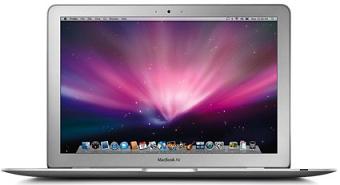
First impressions when using the MacBook Air is that it is visually small. It’s about 1/3 the thickness of a regular MacBook. It is .16 inches at its smallest and .76 inches at the hinge. After it is closed, the laptop is light but doesn’t feel like it’s made of cheap material, it feels like its definitely a Mac that could be used daily. The hinge mechanism is tight and should provide trouble free opening and closing. I see why Apple included a glass screen cover as it keeps the screen from twisting when closing or opening it from either corner.
Performance on the MacBook Air is impressive as it does have an advanced CPU over comparable thin PC laptops. Intel developed the CPU specifically for the MacBook Air. The processors range from a 1.6 GHz or 1.8GHz Core 2 Duo. It also includes 2GB of non upgradeable ram. It is quick at booting, opening apps such as Microsoft Office 2008 and even Photoshop CS 3. Random access disk tests do show however, that the smaller 80GB HD 1.8 inch drive from Toshiba is slower by a single digit percentage margin compared to stock HD’s from a MacBook.
Screen brightness is enhanced by the new LCD backlighting introduced. It still has the same resolution of a MacBook and a 13.3 inch screen. Both models share the 144MB of shared system ram for video memory. This is great news as the MacBook Air should be able to run Windows Vista marginally better than its counterparts in the PC realm.
To finish up the pros, it has a backlit keyboard, iSight camera, 802.11n Draft compliant WiFi (a/b/g also supported), BlueTooth 2.0 + EDR and an ambient light sensor for adjusting both the keyboard and screen backlighting.
Now for the cons, for which there are a few. This is the first model of this line. This isn’t too bad but I do not enjoy being the first adopter of relatively untested hardware. The computer itself is very thin and may not provide enough protection if accidentally dropped or hit with anything. It only has one USB port, no SuperDrive, no Ethernet port, non user replaceable battery and a non standard micro DVI port.
Its accessories include a USB powered SuperDrive, USB Ethernet dongle and a newly designed magnetic charger. The above accessories do not come with the MacBook Air except for the charger.
If users are looking to spend $1,799 on the base model and can live without a SuperDrive then this may be a purchase worth thinking about. Frequent travelers will find its light weight, Windows compatibility and fast WiFi access as something to ponder the next time they make a new computer purchase.